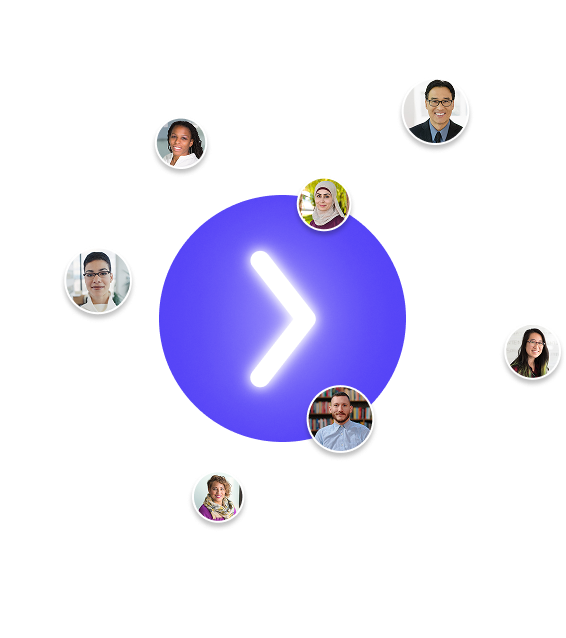
Subscribe to our Blog
We're committed to your privacy. SayOne uses the information you provide to us to contact you about our relevant content, products, and services. check out our privacy policy.

Renjith RajMay 2, 202513 min read

Generating table of contents...
Traditional web automation uses scripts to perform predefined tasks on websites. It's effective for repetitive actions but often breaks when websites change or present unexpected variations.
AI Web Automation takes this a step further. It uses artificial intelligence, particularly large language models (LLMs) and agentic frameworks like LangChain, to give automation capabilities like understanding context, making decisions, and adapting to dynamic environments.
Instead of just following rigid steps, AI agents can interpret goals, interact with web elements more flexibly, and handle unforeseen situations, much like a human would.
These AI agents don't just execute commands; they can reason about the task. They can understand natural language instructions, analyze webpage content semantically (not just structurally), and decide the best course of action based on the current state of the web page and the overall objective.
This makes automation more resilient, capable of handling complex workflows, and easier to manage, as prompts can often replace brittle code.
Our approach focuses on harnessing this intelligence effectively. We define the goal clearly, but instead of mapping out every single click and keystroke, we design AI agents that can figure out the steps themselves.
This involves careful selection of AI models, tools, and the logic that connects them.
Building robust and intelligent AI web automation requires a specific mindset and toolset.
Here’s how we structure our approach:
❝We saw endless frustration with automation breaking due to minor website changes. That’s why our AI agents don't just look for brittle code identifiers. They understand context and visuals, finding elements like 'the submit button' even if its underlying code changes. This adaptability is key to reliable automation.
Our assertion process involves:
Instead, it uses a Plan-and-Execute approach. It assesses the situation based on the outcome of its actions (Update State), adjusts its strategy (Replan), and generates new steps to overcome the obstacle or achieve the original goal through an alternative path, rather than simply halting
This AI-centric approach allows us to build web automation that is not just faster, but smarter, more adaptable, and ultimately more capable of handling the complexities of the modern web.
Designing responsive AI agents means building systems that can understand, adapt, and act in real-time, regardless of how the web environment changes.

The goal is not just to automate tasks, but to create agents that can reason, make decisions, and recover from unexpected situations without manual intervention. We focus on practical, modular design and leverage frameworks like LangChain to keep things simple, robust, and easy to scale.
Here is how we approach to building Web Automation AI Agents
Responsiveness in web automation means more than just speed or uptime. It’s about building AI agents that can adapt to shifting web environments, recover from unexpected changes, and deliver results without breaking.
At SayOne, we recognized early that traditional web automation was fundamentally broken.
❝Our clients struggled with manual automation. Scripts would fail whenever a website’s structure changed, even slightly. Minor UI tweaks, new pop-ups, or dynamic content would bring entire workflows to a halt, causing lost productivity and constant firefighting for engineering teams.
For software development firms and large enterprises, our solution means automation that keeps up with the pace of product evolution. Teams no longer worry about scripts failing after every sprint.
Our AI agents can adapt to changes, reducing manual intervention, increasing test coverage, and freeing up engineering resources for more strategic work. This translates to faster releases, fewer bugs in production, and a tangible boost in productivity.
A global logistics company approached us with a legacy automation setup that was failing every time their online booking system updated its UI. Their QA team was stuck in a cycle of constant script repairs, slowing down releases and risking customer experience.
❝We deployed our generative AI web automation solution, which immediately reduced script failures by over 80%. Our agents adapted to new booking flows and UI changes without intervention. As a result, the client shifted from quarterly to monthly releases.
With this approach, SayOne delivers not just automation, but a resilient, intelligent system that evolves with your business-so you can focus on growth, not maintenance.
Integrating user inputs and real-time feedback means building AI web automation agents that don't just operate blindly but can actively listen, understand, and react to human guidance during a task.
Before this capability, automation was largely a one-way street. You'd launch a script, cross your fingers, and hope it completed successfully.
If it encountered an ambiguity-an unexpected field, a slightly different workflow-it would typically fail or produce incorrect results.
There was no easy way for a user to intervene, correct a misstep, or provide clarification on the fly. This led to frustrating cycles of running, failing, debugging, and re-running, significantly diminishing the value proposition of automation, especially for complex, evolving web applications.
The agents lacked the conversational turn-taking humans find natural.
How does this solution help our core audience?
For software development firms and large enterprises, this capability transforms AI web automation from a rigid tool into a collaborative partner.
It means:
❝At SayOne, we engineer AI automation that doesn’t just follow instructions-it adapts in context. By embedding interaction points, real-time feedback, and multi-modal inputs, our agents resolve ambiguity on the spot. This ensures each solution fits the client’s workflow, not the other way around.”
One of our clients, a large software enterprise, was struggling to automate regression testing for their complex CRM platform. The platform had highly configurable UI elements, and traditional scripts constantly failed when users customized their dashboards.
We implemented our AI web automation solution with integrated real-time feedback capabilities.
During test runs, when the Generative AI agent encountered an unfamiliar custom widget or an ambiguous button label added by a user, instead of failing, it would:
This input was instantly processed, allowing the agent to proceed correctly. This collaborative approach reduced their regression testing time by 60%, drastically cut down on false failures caused by UI customizations, and allowed QA teams to focus on verifying functionality rather than constantly fixing brittle scripts.
Designing dynamic agent workflows means creating automation that isn't just a straight line. It's about building intelligent processes that can loop, branch, make decisions, and coordinate multiple actions based on real-time information.
Before tools like LangGraph, automating complex web interactions was a nightmare.
Teams relied on brittle, linear scripts that would fail the moment a website presented an unexpected option, a required login, or a slightly different user path.
Handling variations meant writing convoluted if-else jungles that were impossible to maintain or scale. Coordinating simultaneous tasks, like checking prices on multiple sites at once, was overly complex or simply not feasible.
To achieve this level of dynamic control and adaptability, we specifically leverage several powerful features within LangGraph:
❝Our implementation of LangGraph lets development teams design automation that matches real-world complexity-handling loops, parallel tasks, and human approvals with ease. This workflow resilience means less time fixing scripts and more time building value, so your teams can focus on innovation, not maintenance.
By using LangGraph to build dynamic, stateful workflows, we provided the client with an automation solution that was not only reliable but also inherently adaptable to the complexities of the web.
Optimizing for scalable web automation means designing AI systems that can handle increasing workloads-more tasks, more complex websites, more users-without degrading performance or requiring constant overhauls.
Before AI-driven scalability, businesses faced significant hurdles. Traditional automation often hit a wall when demands grew; adding more tasks meant exponentially increasing infrastructure costs and maintenance headaches.
Scripts became slow, unreliable, and difficult to manage across different departments or applications.
Scaling wasn't just about adding more servers; it required fundamental redesigns, leading to operational bottlenecks and hindering business growth.
For software development firms and large enterprises, our approach to scalable AI web automation provides a crucial competitive edge. It means your automation infrastructure can grow seamlessly alongside your business needs.
❝You can deploy our AI agents across various functions-from QA testing and data extraction to customer service and compliance checks-without worrying about performance dips or spiraling costs.
This allows development teams to focus on innovation rather than maintenance, speeds up time-to-market for new features, and ensures operational efficiency even during peak loads or business expansion.
Ultimately, it provides a reliable, future-proof automation foundation that supports, rather than hinders, growth.
To achieve this intelligent design, we address the specific nuances of scaling AI agents through several key strategies:
An e-commerce client approached us, struggling with their existing product data scraping automation.
As their product catalog grew exponentially and they expanded to new global markets, their traditional scripts became unusably slow and constantly failed due to website variations across regions. Their system couldn't handle the sheer volume and diversity of data required daily.
We replaced their legacy system with a scalable AI web automation solution built on our principles. We deployed a fleet of specialized AI agents using a modular architecture: some agents focused on navigating different regional site structures, others specialized in extracting specific data points (pricing, stock levels, descriptions), and a central orchestrator managed the workflow dynamically.
We selected AI models optimized for fast text extraction and integrated robust monitoring.
The results were transformative:
By focusing specifically on the challenges of scaling AI in a dynamic web environment, we provided a solution that not only met their current needs but was inherently designed to accommodate future growth without disruption.
SayOne builds resilient, AI-powered agents that adapt dynamically, ensuring your workflows remain robust and efficient. As experts in Generative AI solutions and a trusted software development partner, we deliver outsourced projects that streamline operations and free your team to focus on core innovation.
Let us build the intelligent automation you need.
Contact us today!

We're committed to your privacy. SayOne uses the information you provide to us to contact you about our relevant content, products, and services. check out our privacy policy.

About Author
Chief Technology Officer @ SayOne Technologies | Conversational AI, LLM

We collaborate with visionary leaders on projects that focus on quality